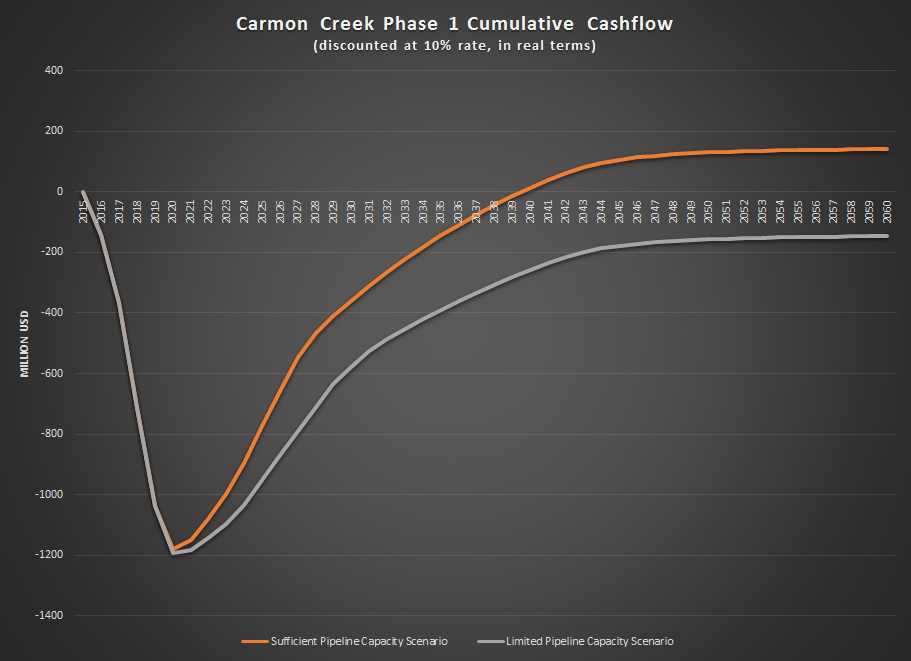Last week, we released a report entitled, Lockdown: the end of growth in the tar sands. The report, based on our unique Integrated North American Pipelines model (INAP), concludes that the tar sands sector is running out of room for growth. This is because with every proposed major pipeline delayed by citizen opposition, an imminent pipeline capacity crunch is poised to hit by 2017.
Within hours of the report’s release, Royal Dutch Shell announced the cancellation of its Carmon Creek tar sands project – an 80,000 barrel per day venture that was already under construction. As a result, Shell is writing down $2 billion in asset revisions and charges. The company stated that the “decision reflects current uncertainties, including the lack of infrastructure to move Canadian crude oil to global commodity markets.”
This is the first major tar sands project that has been stopped mid-construction, writing off sunk costs. Many tar sands projects have been suspended before breaking ground, but cancellations in the construction phase have been unheard of until now. This is a big deal – and with the cancellation of Carmon Creek it is clearer than ever that it is the lack of a new pipeline on the horizon that is causing companies to rein in their tar sands ambitions.
Using the same methodology we employed in the Lockdown report, we analyzed the economics of the Carmon Creek project to see whether or not it would have been cancelled if sufficient pipeline capacity was in place. In this analysis we essentially simulate the process the company would have gone through to assess whether it is worth continuing to invest in the project. During this period of low oil prices, the entire oil and gas industry is looking very carefully at its capital expenditure in order to concentrate limited capital on the most profitable projects. Carmon Creek, like many tar sands projects today, fails the test.
The analysis uses forecast project costs and revenues to estimate an Internal Rate of Return (IRR) over the lifetime of the project. In general, companies consider a roughly 10% IRR as sufficient to move a project forward, reflecting the cost of capital and the opportunities to make higher profits elsewhere. The precise threshold may differ according to their assessment of risk, and the shape of their broader project portfolio.
In our analysis, illustrated in the chart above, we write off capital already spent since 2012, as Shell would have done, to see how the project performs under the current oil price scenario (EIA 2015 Reference Case) assuming that transport costs are kept low due to sufficient pipeline capacity. The project takes some 19 years to break even (relative to the 10% baseline) from its 2020 start date but still in the long run returns an adequate IRR of around 10.8%.
However, when we add the cost of rail transport to the project’s expenditure, the project does not reach the 10% goal, returning a mere 8.7%. In this case, the capital yet to be spent on the project would be better spent elsewhere. Even writing off capital already spent, the company can only conclude that continuing to construct the project is throwing good money after bad.
Back in May 2015, when Shell announced that it would slow down Carmon Creek and push its start up date back two years to 2019, it would appear that it probably saw the falling oil price as the biggest challenge, and would simply wait a bit longer for prices to pick up.
However, since then market access has become a much bigger issue. The rejection of Keystone XL now seems to be a matter of when and not if. Kinder Morgan’s Transmountain expansion plan is being pushed back by an extended environmental review and the regulatory application for TransCanada’s Energy East project has been pushed back at least two years. Suddenly, the chances of having adequate pipeline capacity in place before 2020 appear far from certain.
The landscape is changing for the tar sands. Check out our Lockdown report to find out more about how pipeline constraints – driven by public concern for the climate, environmental, and social impacts – may very well mean the end of growth in the high cost, high carbon, high risk tar sands.

